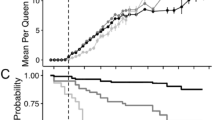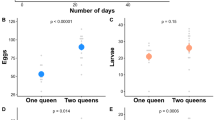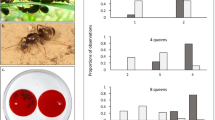Abstract
HYPOTHESES on the evolution of sociality in the Hymenoptera have focused on two non-exclusive selective processes. First, individuals may help relatives to enhance inclusive fitness (kin selection1,2). Second, group living may be so highly advantageous that competitively inferior individuals are forced into subordinate roles through social competition3–7; in this hypothesis, subordinates help dominants in the expectation that they may benefit from the group's resources if the dominants lose status or die. Many social Hymenoptera associate predominantly with close relatives8,9, which precludes an effective comparison of kin selection and social competition. Here we report on the existence of foraging specialists among unrelated co-foundresses of the leaf-cutter ant Acromyrmex versicolor; such task specialization leaves the forager at a relative fitness disadvantage within her foundress association. Contrary to the predictions of social competition theory, individuals specialize independently of competitive ability (as measured by relative body size) or reproductive status (as measured by ovarian condition) and without conflict. The selective basis of foraging specialization may lie in the intense competition that occurs among newly founded colonies engaged in reciprocal brood raiding.
This is a preview of subscription content, access via your institution
Access options
Subscribe to this journal
Receive 51 print issues and online access
$199.00 per year
only $3.90 per issue
Buy this article
- Purchase on Springer Link
- Instant access to full article PDF
Prices may be subject to local taxes which are calculated during checkout
Similar content being viewed by others
References
Hamilton, W. D. A. Rev. Ecol. Syst. 3, 193–232 (1972).
West Eberhard, M. J. Q. Rev. Biol. 50, 1–33 (1975).
West Eberhard, M. J. Science 200, 441–443 (1978).
West Eberhard, M. J. Proc. Am. phil. Soc. 123, 222–234 (1979).
West Eberhard, M. J. in Natural Selection and Social Behavior (eds Alexander, R. D. & Tinkle, D. W.) 3–17 (Chiron Press, New York, 1981).
Vehrencamp, S. L. Anim. Behav. 31, 667–682 (1983).
Fletcher, D. J. C. & Ross, K. G. A. Rev. Entomol. 30, 319–343 (1985).
Gamboa, G. J., Reeve, H. K. & Pfennig, D. W. A. Rev. Entomol. 31, 431–454 (1986).
Breed, M. D. & Bennett, B. in Kin Recognition in Animals (eds Fletcher, D. J. C. & Michener, C. D.) 243–285 (Wiley, Chichester, 1987).
Rissing, S. W. & Pollock, G. B. in Interindividual Behavioral Variability in Social Insects (ed. Jeanne, R. L.) 179–222 (Westview, Boulder, 1988).
Rissing, S. W. & Pollock, G. B. Anim. Behav. 34, 226–233 (1986).
Rissing, S. W., Johnson, R. A. & Pollock, G. B. Psyche 93, 177–186 (1986).
Pamilo, P. Genetics 107, 307–320 (1984).
Hagen, R. H., Smith, D. R. & Rissing, S. W. Psyche (in the press).
Crozier, R. H., Pamilo, P. & Crozier, Y. Behavl Ecol. Sociobiol. 15, 143–150 (1984).
Wilkinson, G. S. & McCracken, G. F. Evolution 39, 1169–1174 (1985).
Wilson, D. S. Am. Nat. 111, 157–185 (1977).
Wilson, D. S. A. Rev. Ecol. Syst. 14, 159–187 (1983).
Wade, M. J. Am. Nat. 125, 61–63 (1985).
Michener, C. D. The Social Behavior of the Bees (Belknap Press of Harvard University Press, 1974).
Gamboa, G. J., Heacock, B. D. & Wiltjer, S. L. J. Kans. Entomol. Soc. 51, 343–352 (1978).
Traniello, J. F. A., Fujita, M. S. & Bowen, R. V. Behavl Ecol. Sociobiol. 15, 65–68 (1984).
West Eberhard, M. J. J. Kans. Entomol. Soc. 51, 832–856 (1978).
Michener, C. D. in Experimental Behavioral Ecology and Sociobiology (eds Hölldobler, B. & Lindauer, M.) 293–305 (Sinauer, Sunderland, 1985).
Rissing, S. W. & Pollock, G. B. Anim. Behav. 35, 975–981 (1987).
Jeanne, R. L. A. Rev. Entomol. 25, 371–396 (1980).
Ito, Y. in Animal Societies: Theories and Facts (eds Itô, Y., Brown, J. L. & Kikkawa, J.) 17–34 (Japan Sci. Soc., 1987).
Hölldobler, B. & Wilson, E. O. Naturwissenschaften 64, 8–15 (1977).
Pfennig, D. W. & Klahn, J. E. Z. Tierpsychol. 67, 198–203 (1985).
Wcislo, W. T. Behavl Ecol. Sociobiol. 15, 157–160 (1984).
Pollock, G. B. & Rissing, S. W. Am. Nat. 133, 61–70 (1989).
Gamboa, G. J. thesis, Arizona State Univ., 1974.
Menzel, R. in Experimental Behavioral Ecology and Sociobiology (eds Hölldobler, B. & Lindauer, M.) 55–74 (Sinauer, Sunderland, 1985).
Traniello, J. F. A. in Interindividual Behavioral Variability in Social Insects (ed. Jeanne, R. L.) 91–112 (Westview, Boulder, 1988).
Pollock, G. B. & Rissing, S. W. in The Ecology of Social Behavior (ed. Slobodchinkoff, C. N.) 315–334 (Academic, San Diego, 1988).
Author information
Authors and Affiliations
Rights and permissions
About this article
Cite this article
Rissing, S., Pollock, G., Higgins, M. et al. Foraging specialization without relatedness or dominance among co-founding ant queens. Nature 338, 420–422 (1989). https://doi.org/10.1038/338420a0
Received:
Accepted:
Issue Date:
DOI: https://doi.org/10.1038/338420a0
This article is cited by
-
Multi-queen breeding is associated with the origin of inquiline social parasitism in ants
Scientific Reports (2022)
-
Decoupled evolution of mating biology and social structure in Acromyrmex leaf-cutting ants
Behavioral Ecology and Sociobiology (2022)
-
Age-related division of labor occurs in ants at the earliest stages of colony initiation
Behavioral Ecology and Sociobiology (2021)
-
Social structure of the polygynous ant, Crematogaster osakensis
Insectes Sociaux (2017)
-
The foundress’s dilemma: group selection for cooperation among queens of the harvester ant, Pogonomyrmex californicus
Scientific Reports (2016)
Comments
By submitting a comment you agree to abide by our Terms and Community Guidelines. If you find something abusive or that does not comply with our terms or guidelines please flag it as inappropriate.



